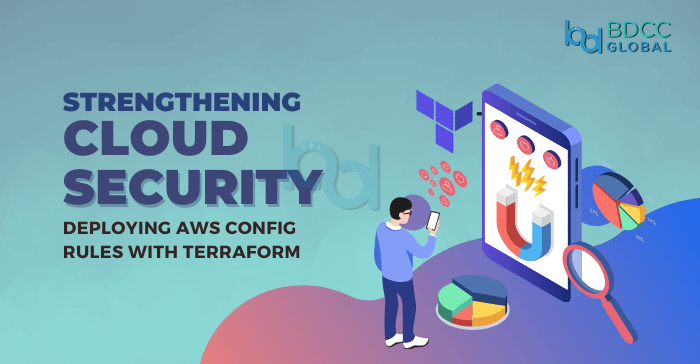
In the cloud-oriented universe of today, security and compliance tallies as the most critical concern for organizations irrespective of their size. As businesses migrate their workloads onto the cloud platform, the implementation of security measures gets on the priority list. AWS Config is a service offered by AWS that enables organizations to assess, audit, and evaluate the configurations of AWS resources. Security compliance automation and enforcement, using these configurations, can be accomplished with AWS Config Rules.
Terraform, a popular Infrastructure-as-Code (IaC) tool, offers an efficient way to implement AWS Config Rules and automate security measures. By leveraging Terraform, organizations can standardize their security policies, reduce manual efforts, and maintain compliance with industry regulations.
This blog will explore the importance of AWS Config Rules, how they enhance cloud security, and the steps to implement them using Terraform. We will also discuss best practices and how top AWS consulting companies can assist businesses in ensuring security automation.
What is AWS Config?
AWS Config is a fully managed service that enables organizations to assess, audit, and evaluate AWS resource configurations. It continuously monitors and records AWS resource configurations and allows users to track changes over time.
What are AWS Config Rules?
AWS Config Rules are predefined or custom rules that evaluate AWS resource configurations against specific conditions. These rules help organizations ensure compliance with security policies and best practices.
Types of AWS Config Rules:
AWS Config Rules help businesses enforce security compliance effectively. These rules fall into two main categories:
- AWS Managed Rules: Predefined rules created by AWS to enforce best practices and ensure security standards are met.
- Custom Rules: User-defined rules tailored to specific security and compliance requirements, offering greater flexibility in governance.
Benefits of AWS Config Rules:
AWS Config Rules provide several benefits that enhance cloud security and streamline compliance management. Below are the key advantages:
- Continuous monitoring of AWS resources: AWS Config Rules constantly evaluate resource configurations, ensuring that security and compliance standards are maintained across an organization’s cloud environment.
- Automated compliance reporting: Organizations can generate real-time compliance reports, which help meet regulatory requirements without extensive manual effort.
- Simplified security audits: AWS Config keeps a history of configuration changes, making it easier for auditors to review security posture and identify potential vulnerabilities.
- Immediate notifications for non-compliant configurations: Whenever a resource becomes non-compliant, AWS Config sends alerts, enabling teams to take swift action and remediate security risks.
- Integration with AWS security services: AWS Config Rules integrate with other AWS security tools, such as AWS Security Hub and AWS CloudTrail, to provide a holistic security and compliance framework.
Why Use Terraform for AWS Config Rule Implementation?
Benefits of Terraform for AWS Security Automation:
Infrastructure as Code (IaC): Enables consistent, repeatable, and automated deployment of AWS resources.
Scalability: Easily deploy security configurations across multiple accounts and regions.
Version Control: Maintain compliance configurations in a version-controlled repository.
Automation: Reduces manual efforts by automating security policies and compliance checks.
Cost Efficiency: Minimizes security risks that could lead to financial penalties due to compliance violations.
Implementing AWS Config Rules with Terraform
Following a step-by-step approach, businesses can easily implement AWS Config Rules with Terraform. Key Steps for implementation include:
Set Up AWS Config: Ensure AWS Config is enabled with a defined configuration recorder and delivery channel.
Define AWS Config Rules: Establish rules that enforce security compliance across cloud resources.
Deploy Security Policies: Use Terraform to automate rule deployment for consistent enforcement.
Monitor and Remediate: Continuously monitor resources and take corrective actions when non-compliance is detected.
Best Practices for AWS Config Rules with Terraform
To maximize the effectiveness of AWS Config Rules, organizations should follow best practices that ensure scalability, security, and ongoing compliance. Below are five essential best practices to consider when implementing AWS Config Rules using Terraform.
Use a Modular Terraform Structure
A modular Terraform structure helps in organizing code efficiently for reusability and scalability. By structuring Terraform files into separate modules, organizations can maintain a cleaner codebase, making it easier to manage and scale security configurations across different environments. Security configurations should be divided into distinct modules to ensure clarity and efficiency.
Implement Least Privilege Access
To enhance security, it is essential to grant only the minimum necessary permissions to IAM roles and users. Ensuring that IAM roles have strictly the required permissions minimizes the risk of unauthorized access. Organizations should enforce IAM policies that restrict access to sensitive resources, reducing the likelihood of accidental or malicious misconfigurations.
Enable Multi-Account Security Compliance
Many organizations operate in multi-account environments, requiring a centralized security approach. Deploying AWS Config Rules across multiple AWS accounts using AWS Organizations ensures that security policies are consistently enforced. By managing compliance at the organizational level, businesses can maintain uniform security standards across all cloud environments.
Automate Remediation Actions
Automation plays a crucial role in maintaining a secure AWS environment. Organizations should integrate automated remediation actions to correct non-compliant configurations immediately. By establishing predefined workflows for security incidents, businesses can reduce manual intervention and ensure faster response times to potential security threats.
Regularly Review and Update Rules
Security and compliance requirements evolve over time, requiring organizations to update their AWS Config Rules accordingly. Regularly reviewing security policies ensures that AWS environments remain compliant with the latest standards. Additionally, using version control helps track changes in security configurations, providing better visibility into adjustments made over time.
How AWS Consulting Companies Can Help
Top AWS consultants can assist organizations in implementing AWS Config Rules with Terraform by:
Assessing Security Posture: Identifying security gaps and compliance risks.
Designing Custom Config Rules: Creating tailored security policies to meet industry-specific requirements.
Automating Security Compliance: Deploying security automation strategies for continuous monitoring.
Providing Ongoing Support: Offering 24/7 monitoring and compliance management.
Conclusion
Implementing AWS Config Rules with Terraform is a powerful approach to enhancing cloud security and ensuring compliance automation. By leveraging Infrastructure-as-Code, organizations can efficiently enforce security policies, minimize risks, and maintain a robust security posture.
Top AWS consulting companies can further streamline the process by providing expert guidance, automation strategies, and ongoing support. As cloud security threats evolve, leveraging AWS Config Rules with Terraform remains a proactive strategy for organizations aiming for strong cloud governance.
By following best practices and implementing AWS security automation, businesses can confidently manage their AWS environments while ensuring compliance with industry standards. Start your AWS security automation journey today with Terraform and AWS Config Rules!
BDCC
Latest posts by BDCC (see all)
- Four Steps to Balance Agility and Security in DevSecOps - April 22, 2025
- Enhancing Security Posture with Azure’s AI-Driven Threat Detection - April 15, 2025
- Why Golang is Becoming the Go-To Language for DevOps Engineers - April 11, 2025

